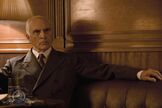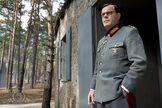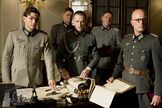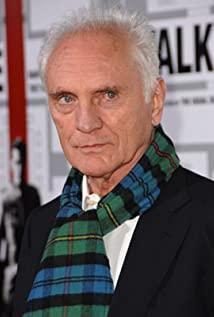In 1944, due to dissatisfaction with Hitler's expansionary policy, Colonel Klaus von Stauffenberg, chief of staff of the German Third Reich's domestic garrison, decided to join several anti-war officers to assassinate Hitler, and the assassination was carried out. The code-named "Valkyrie" revenge plan.
In June 1944, Stauffenberg was promoted to colonel by the German army and appointed chief of staff to General Fromm, the commander-in-chief of the domestic garrison. This position allowed him not only to issue orders to the Wehrmacht in Fromm's name, but also to have more direct and regular contact with Hitler. On July 7, 1944, Stauffenberg went to report to Hitler's office, and he placed a time bomb in his briefcase. But since Goering and Himmler were not present at the time, Stauffenberg ultimately missed the assassination opportunity.
The conspiracy of July 20, 1944 was the pinnacle of the assassination of Hitler, not just a plan to assassinate Hitler, but a blueprint to overthrow the entire Nazi government. In the end, the conspiracy failed, about 200 people were hanged for their involvement in the case, about 700 people were arrested for being directly related to the case, and in August, about 5,000 people were arrested because they were deemed to be A potential enemy of the Nazi Empire. But in the long run, the conspiracy revealed a side of Germany that had long been unknown. Despite being seen as traitors for many years, all those involved in the July 20 conspiracy were also recognized by Germany for their courage and sacrifice. In 2004, then German Chancellor Gerhardt. Schroeder paid tribute to Stauffenberg and his countrymen, saying their actions were a reminder to this country that even today, the value of freedom is self-evident and that we must continue to defend that belief.
2. "Loyalty to Hitler or Loyalty to Germany?" - a moral dilemma
"Action Target Hitler" is based on real historical events during World War II, when many elites in the army were from the aristocratic class and were loyal to the country all their lives. They enlisted to fight in World War I long before Hitler's rise; Stauffenberg entered the military in 1926. In the mid-1930s, violence intensified against Jews and other races, many of whom questioned Hitler's policies. The cultural background gave them the notion that once you make a promise, you have to keep it for the rest of your life; and these people have all sworn allegiance to Hitler. These nobles have a strong sense of mission and take the well-being of the country's people as their own responsibility, but they later understand that Hitler and his men have committed those inhumane atrocities that have run counter to their oath to the country. They understand that, even if they may be charged with treason, something must be done for the future of their country. This is a morally painful dilemma. As the war progressed, many people became more aware of Hitler's true colors and began to learn of the unequal treatment that had happened to Russians and Jews. Thus began to participate in anti-Nazi actions.
Hitler's horrific atrocities against Jews, Russians, and prisoners of war were, for Stauffenberg and many others, a key factor in coming forward. The force of justice seems to play an important role at this time. Bryan Singer believes that he was surprised that many members of the resistance movement were dissatisfied with Hitler at an early stage; and after learning the truth about the inhuman treatment of Jews and the Holocaust, their loyalty was greatly affected . This is the key to prompting them to stand up and resist regardless of the cost.
3. The people
of Stauffenberg Stauffenberg was born in a German aristocratic family with a history of 700 years and grew up in an elite family in Bavaria. With artistic cells, he loved poetry, music and architecture, but he chose to join the army in 1920. He quickly gained attention due to his strong individualism and heroic aura. It is said that his superiors valued his talent in military organization and logistics, which made him stand out among his peers.
In early 1943, while fighting in Africa, Stauffenberg was seriously wounded; he lost an eye, his right hand, and several fingers of his left hand. Despite his injuries, he was named chief of staff of the Army Department in the fall of 1943. At the time he had joined the Resistance. On July 1, 1944, Stauffenberg became Chief of Staff of the Reserve Army, allowing him to meet directly with Hitler. He suddenly found himself in an excellent position to assassinate Hitler.
Historian Anna Doreber described Stauffenberg this way: "[He was] a model for those young high-ranking officers who, despite a bright future, did not rest on their laurels and was determined to act for justice. He had officers in the army. One should have a sense of responsibility, and one should have a sense of responsibility as a citizen in the face of the people. Even the Gestapo who participated in the investigation of the July 20 incident could feel his spirit."
4. About the "Wolf's Den"
World War II During this period, after Hitler conquered France, he began to formulate the "Barbarossa Plan" to invade the Soviet Union. In order to facilitate direct command of operations against the Soviet Union, Hitler decided to establish a secret command post near the Soviet border. After many explorations and site selections, the site was finally identified as Gailwash (now in Masur province in Poland) near Kentschen in East Prussia, commonly known as "Wolf's Den", which is also an alias taken from Hitler himself. "Wolf". "Wolf's Den" is located more than 300 kilometers northeast of Warsaw, only 80 kilometers away from the border of the former Soviet Union.
Later experts summed up the reasons for Hitler's site selection based on relevant information: At that time, it was under the jurisdiction of Germany, and most of the residents here were Germans or their descendants; to the east of the "Wolf's Den", three huge lakes and criss-crossing rivers and The swamp forms a natural barrier; the surrounding tall and dense coniferous and broad-leaved mixed forest is naturally the best choice for the "wolf's den" air defense. The woods were taller and denser than they are now, trees and turf were planted on top of any buildings in the "Wolf's Den", and hardly any buildings or railway lines were visible from the air.
According to statistics, Hitler himself spent a total of 800 days before and after the "wolf's den", and his staff and senior officers are also increasing. According to statistics, in 1944, there were more than 2,000 Germans living and working here in the "Wolf Den", including more than 300 marshals, generals and senior government officials, and more than 1,200 Hitler's personal guards. This is the largest command post built by Hitler during World War II. It can even be called a small city, including two airports, two power stations, a railway station, a communication hub, and even a cinema and other officers' living facilities. , a total of 80 buildings of various types.
On November 20, 1944, Hitler left the "Wolf's Den". In January 1945, the Soviet Red Army captured the town of Gailwash near the "Wolf's Den". On January 24, German sappers completely destroyed the "Wolf's Den" base camp. It is said that at least 8 tons of high explosives are needed to blow up a heavy defensive fortress. Three days later, the Soviet Red Army occupied the "Wolf's Den", but it was just an undefended ruin.
Little Tom's acting is really good!
The heroine's eyes are beautiful, with love, kindness and virtuousness in her eyes.
View more about Valkyrie reviews











